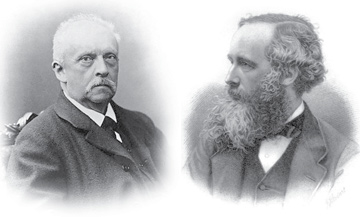 Quantum formalisms of the scalar optics of Herrmann von Helmholtz (left) and the wave optics of James Clerk Maxwell (right) can unify the mathematical treatment of beam optics and polarization. For some key systems, the formalisms lead to alternative, expanded beam-optical Hamiltonians with previously underived wavelength-dependent terms. [Wikimedia Commons]
Quantum formalisms of the scalar optics of Herrmann von Helmholtz (left) and the wave optics of James Clerk Maxwell (right) can unify the mathematical treatment of beam optics and polarization. For some key systems, the formalisms lead to alternative, expanded beam-optical Hamiltonians with previously underived wavelength-dependent terms. [Wikimedia Commons]
The understanding and manipulation of beam optics and light polarization are cornerstones of optical technology. During 2016, we outlined new quantum formalisms for both the Helmholtz equation and for Maxwell’s equations that enable the description of beam optics and light polarization in a unified framework.
The traditional scalar theory of light-beam optics uses Fermat’s principle of least time to obtain the beam-optical Hamiltonian. Geometrical optics can also be developed from the Helmholtz equation, itself derived from Maxwell’s equations. In this approach, the beam-optical Hamiltonian is deduced by taking the “square-root Helmholtz operator”—an expression that is itself not exact and rigorous, and leaves room for alternative procedures.
The Helmholtz wave equation governing scalar optics is mathematically very similar to the Klein–Gordon equation for relativistic spin-0 particles. Thus, we were able to use quantum methods to develop a nontraditional prescription of Helmholtz optics.1 We have also developed a quantum formalism of Maxwell optics more generally,2 starting with an exact matrix representation of Maxwell’s equations for a medium with varying permittivity and permeability.3 We found that the beam-optical Hamiltonian derived using this matrix representation is exact, and has an algebraic correspondence with the Dirac equation, which lets us employ quantum methods.
The resulting formalism has been successful in describing beam optics (including aberrations to all orders) accompanied with wavelength-dependent contributions at each order, starting with the lowest-order paraxial Hamiltonian.4 The newly developed formalism has also let us obtain the elegant Mukunda–Simon–Sudarshan rule for passage from scalar to vector wave optics as a paraxial limit of Maxwell optics.2
These new formalisms provide a natural framework to study beam optics and polarization in a unified manner.5 For example, we were able to apply both the nontraditional prescription of Helmholtz optics and our new formalism for Maxwell optics to the case of an axially graded-index medium.1,2 In both cases, the resulting mathematics produces paraxial Hamiltonians with the traditional terms, modified by additional wavelength-dependent terms that are completely absent from the traditionally derived expressions. The Maxwell optics formulation also includes matrix terms related to polarization.
In the limit of low wavelength, the nontraditional prescriptions of Helmholtz optics and Maxwell optics lead to a Lie algebraic formalism of optics. These new formalisms extend Hamilton’s optical-mechanical analogy into the wavelength-dependent regime. In a larger sense, we can now compare the Hamiltonians of light-beam optics with those of charged-particle-beam optics in traditional/classical and nontraditional/quantum regimes. The quantum methods and the Foldy–Wouthuysen transformation technique, in particular, illuminate new aspects of the analogies between light-beam optics and charged-particle-beam optics.5
Researcher
Sameen Ahmed Khan, Dhofar University, Salalah, Oman
References
1. S.A. Khan. Optik 127, 9798 (2016).
2. S.A. Khan. J. Mod. Optics, 63, 1652 (2016).
3. S.A. Khan. Phys. Scripta, 71, 440 (2005).
4. S.A. Khan. Optik, 125, 968 (2014).
5. S.A. Khan. Adv. Imag. Elect. Phys. 152, 49 (2008).
